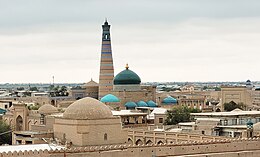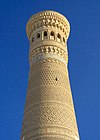Itchan Kala
| UNESCO World Heritage Site | |
|---|---|
 View of Itchan Kala | |
| Location | Khiva, Uzbekistan |
| Criteria | Cultural: (iii), (iv), (v) |
| Reference | 543 |
| Inscription | 1990 (14th Session) |
| Area | 37.5 ha (93 acres) |
| Coordinates | 41°22′42″N 60°21′50″E / 41.37833°N 60.36389°E |
Itchan Kala (Uzbek: Ichan-Qаl’а) is the walled inner town of the city of Khiva, Uzbekistan. Since 1990, it has been protected as a World Heritage Site.
The old town retains more than 50 historic monuments and 250 old houses, dating primarily from the eighteenth or nineteenth centuries. Juma Mosque, for instance, was established in the tenth century and rebuilt from 1788 to 1789, although its celebrated hypostyle hall still retains 112 columns taken from ancient structures.
Notable buildings in Itchan Kala are Konya Ark, Juma Mosque, Ak Mosque, Hasanmurod Qushbegi mosque, madrasahs of Alla-Kulli-Khan, Muhammad Aminkhon, Muhammad Rakhimkhon, Mausoleums of Pahlavon Mahmoud, Sayid Allavuddin, Shergozikhon as well as caravanserais and markets.[1]
Legend of origin
[edit]According to the legend, in the construction of the Ichan-Qal'a fortress, Muhammad the Prophet of Islam used bricks brought from the places he had conquered, and later, it became a sacred place.[2][3][4] In another legend, it is said that the sacred water channel of Khiva, known as the Xeyvak Canal, was dug by Shem, the son of Noah, who was said to have a miraculous spade.[4] Similarly, according to the tales, the construction of Khorezm began with Shem.[2][3][5]
Walls
[edit]In Khiva, the city is divided into two parts in the traditional way: the Inner City (Itchan Kala) surrounded by the Inner Defensive Wall, and the Outer City (robod) known as Dishan-Qal'a, surrounded by the Outer Defensive Wall.[6][7][8]
The walls of the Itchan Kala are 8–10 meters high, 5–6 meters thick, and have a total perimeter length of 6250 meters. Both the outer and inner defensive walls are made of mud bricks.[2][3] At intervals of every 30 meters along the inner city walls, there are watchtowers that project outward. The upper part of the walls features crenellations for shooting at enemies during times of conflict. Water-filled moats were part of the defensive system, and remnants of these can still be seen in the southern part of the city, while in the north and west, ancient clay pipes were used to cover the moats.
The city gates were also an integral part of the defensive system.[6][8] The remaining gates are Bogcha Gate (North), Polvon Gate (East), Tosh Gate (South) and Ota Gate (West). They demonstrate that they were equipped with "zarba" towers on both sides of the passage, and galleries above the gate. The gates themselves often led to arched passageways, and if the road was particularly long, they featured multiple domes.
Structure
[edit]The history of the construction of architectural monuments in Itchan Kala is mainly divided into 4 periods:
- The first period extended from the ancient period of Khorezm to the period of the Mongol invasion.The western wall of the Konya Ark, the ancient tower in the northeast corner of the castle wall, and the remains of the castle wall have been preserved from that period.
- The second period was the restoration period of Khorezm after the Mongol invasion in 1220. During this period, Said Alovuddin mausoleum and other magnificent buildings were built.
- The third period corresponds to the XVI-XVII centuries. At that time (during the reign of Abulgazi Khan and Asfandiyar Khan), Anusha Khan's bathhouse (1657), Ak Mosque (1675), madrasah of Khojamberdibi (1688) were built in Itchan Kala. The fortifications of the Konya Ark were strengthened, a viewing hall (the reception hall of the khan) was built (1686-1688). As a result of the war between Bukhara and Iran for the Khanate of Khiva (1st half of the 18th century), the Itchan Kala and in general the city of Khiva were severely damaged (Khiva was a province dependent on Iran for some time).
- The fourth period includes the 18th-20th centuries. During this period, mosques, madrasas, tims and mosques were built based on the traditions of local Central Asian architecture. A main road was built between 2 gates of Itchan Kala. At the end of the 18th century, the Juma Mosque was rebuilt and a tall minaret was erected next to it. The ruined walls of the Itchan Kala were restored, several buildings were repaired. In 1840-1842, the two-storey tim (an indoor market) was built in front of Kutlugmurad Inaq madrasah. During the reigns of Muhammad Rahim Khan I (1806-1825), Alla-Kulli-Khan (1825-1842) and Muhammad Amin Bahadur Khan (1845-1855), the construction of the Itchan Kala was accelerated. A magnificent palace, madrasah, mausoleums were built: the construction of the palace in the Konya Ark was completed. A new and large Toshhovli Palace was built. A part of the fortress wall near the Polvan Gate was destroyed, and the Alla-Kulli-Khan caravan palace, madrasah and tim were built in its place, and the Pahlavon Mahmud Mausoleum which is a wonderful example of folk art, was erected. Arab Muhammad Khan and Musa Torah Madrasahs were also created during that period. Muhammad Amin Khan built a minaret known as Kaltaminor in the western part of the Itchan Kala - next to the Konya Ark. Although this minaret was not finished, it is well-known among other monuments of Itchan Kala.[2]
Gallery
[edit]-
West gate
-
Itchan Kala walls
-
A street in the old city
-
Itchan Kala by night
-
Alla Kouli Khan madrasa
See also
[edit]- Dishan Kala
- Pahlavon Mahmud complex
- Arab Muhammadkhan Madrasah
- Muhammad Aminkhan Madrasah
- Ishrat Hovli
References
[edit]- ^ Itchan Kala, UNESCO World Heritage Centre.
- ^ a b c d "ИЧАН-КАЛА – СТАРЫЙ ГОРОД В ХИВЕ". kstrip.ru. 30 June 2019. Retrieved 2023-11-04.
- ^ a b c "Ichan-Qal'a". uzbek-travel.com. Retrieved 2023-11-04.
- ^ a b ""Hey, voh", ya'ni Xiva haqida afsona, haqiqat va qiziq faktlar (fotosayohat)". darakchi.uz. Retrieved 2023-11-04.
- ^ "Xiva". dsr.nii.ac.jp. Retrieved 2023-11-04.
- ^ a b "Xiva-Ichan qala". www.sayyoh.com. Archived from the original on 2023-12-08. Retrieved 2023-11-04.
- ^ "Ichan-Kali arxitekturasi". www.tourister.ru. Retrieved 2023-11-04.
- ^ a b "Xivadagi Ichan qal'a yirik va noyob me'moriy yodgorlikdir". ilmlar.uz. 16 March 2023. Retrieved 2023-11-04.








